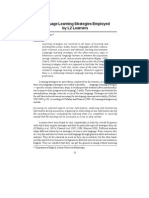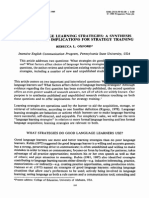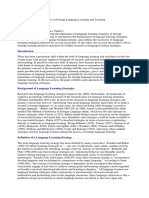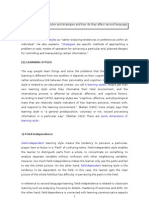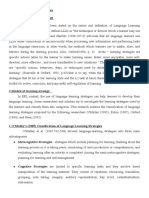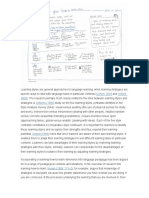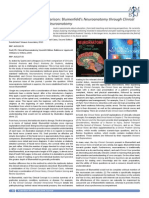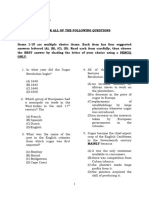J.
JOHN SEKAR
THE AMERICAN COLLEGE
Language Learning Strategies in a Nutshell: Update and ESL Suggestions
REBECCA L. OXFORD
Learning Strategies
i. Interests in learning strategies started with the publication of papers collectively
known as the “good language learner” studies (Cohen & Weaver, 1998)
ii. Since then, hundreds of studies have been generated that studied different aspects of
learning strategies and their roles in language learning.
iii. Oxford differentiates learning strategies into the following categories:
a) Cognitive
Cognitive strategies involve the identification, retention, and retrieval of
language elements. For example, students may use memory-enhancing
strategies to help them remember new words.
b) Metacognitive
Metacognitive strategies deal with the planning, monitoring, and evaluation of
language learning activities. For example, students may develop a plan for
monitoring their progress by constantly comparing their current level of
proficiency with the course goals.
c) Affective
Affective strategies are those that serve to regulate emotions, attitudes, and
motivation. For example, students may read linguistically simplified books to
develop a positive attitude toward reading materials.
d) Social
Social strategies refer to actions that learners take to interact with users of the
language. For example, students may deliberately seek out opportunities to use
the target language with native speakers of the language.
iv. Language learning strategies remain an active area of research. In spite of extensive
research, many theoretical and practical issues still need to be addressed.
Definition
i. Strategies are tools for the self-directed involvement necessary for developing
communicative ability.
ii. They are specific actions, behaviours, steps or techniques that students often use to
improve their progress in developing L2 skills.
� iii. These strategies facilitate the internalization, storage, retrieval, or use of the new
language.
iv. Examples:
• Watching English channels, and guessing the meaning of new expressions and
predicting what will come next;
• Memorizing pages of words from a dictionary and breaks words into their
components;
• Meeting English speaking partners as often as possible;
• Living or spending more time with native speakers so that they can learn the
culture and language in a fulltime immersion situation;
• Putting English labels to all objects in one’s study room or kitchen;
• Practising song lyrics and moving freely to the music while singing;
• Reading the English dailies and comic books;
• Using a green highlighting pen to mark the main points in the notes being
taken in class, later outlining the notes and writing summaries;
• Keeping a diary to evaluate daily performance in learning English.
Learning about Learning Strategies
i. Frequently used techniques for assessing students’ L2 strategies include:
ii. Informal or formal interviews, group discussions, language learning diaries, and
dialogue journals between student and teacher.
iii. Observational methods are difficult because many learning strategies are internal and
therefore invisible to observers.
iv. Therefore, much learning-strategy research depends on learners’ willingness and
ability to describe their internal behaviours, both cognitive and affective.
Research Findings
i. Effective learners actively associate new info with existing info in long-term memory,
building increasingly intricate and differentiated mental structures or schemata.
ii. Successful learners often use metacognitive strategies, such as organising, evaluating,
and planning their learning.
iii. Use of cognitive strategies such as analysing, reasoning, transferring information,
taking notes and summarizing contributes to effective learning.
iv. A number of the best learners use affective and social strategies to control their
emotions, to stay motivated, to cooperate, and to get help.
�v. Rubin (1975): Good language learners
a) Willingly and accurately guess
b) Want to communicate
c) Are uninhibited about mistakes
d) Focus on both structure and meaning
e) Take advantage of all practice opportunities, and
f) Monitor their own speech and that of others
vi. Naiman, Frohlich, & Todesco (1975): successful language learners think in the
language and address the affective aspects of language learning.
vii. Appropriate use of language learning strategies results in improved L2 proficiency
overall or in specific language skill areas.
viii. Effective L2 learners are aware of the strategies they use and why they employ
them.
ix. Skilled L2 learners select strategies that work well together and that are tailored to the
requirements of the language task.
x. For high-performing L2 learners, cognitive and metacognitive strategies often go
together.
xi. Learners far less often cite social and affective strategies. It may be because
researchers fail to ask about them in detail.
xii. Less skilled L2 learners sometimes are not even aware of the noncommunicative or
rather mundane strategies they use such as translation, rote memorization and
repetition.
xiii. However, many of the less effective L2 learners are indeed aware of the strategies
they use, can describe them clearly, and actually use as many strategies as
effective L2 learners. But they apply these strategies in a random manner, without
targeting the strategies to the task.
xiv. L2 strategy training is frequently successful. The most effective strategy training
is explicit: Learners are told overly that a particular behaviour or strategy is likely
to be helpful, and they are taught how to use it and how to transfer it to new
situations. Blind training is less successful in the transfer of strategies to new
tasks. Strategy training succeeds best when it is woven into regular class activities
on a normal basis.
� xv. Factors influencing the L2 learners’ choice of learning strategies include motivation,
career/academic specialization, sex, cultural background, nature of task, age, and
stage of language learning.
a) More motivated learners typically use more strategies than less motivated
learners.
b) Career or academic orientation is significant in strategy choice. For example,
engineering/science students choose learning strategies that are more analytic
than those selected by humanities students.
c) Women students report greater strategy use than men students.
d) Cultural background also correlates with strategy choice: rote memorization is
more prevalent among Asian ESL students than their Hispanic counterparts.
e) The nature of the task—conversation vs. letter writing, listening for details vs.
listening for the main idea—helps to determine the strategies used to the
activity.
f) Students of different ages and stages of L2 learning use different learning
strategies, with more sophisticated strategies often being employed by more
advanced students.
xvi. Language learning style (general approach to language learning) has been
identified as another key determiner of L2 strategy choice.
a) When they are not pressured by environment, students often use strategies that
directly reflect their preferred learning. For example, students with analytic
learning style prefer strategies such as contrastive analysis, rule learning, and
dissecting words and phrases, whereas students with global style use strategies
that help them find the big picture—guessing, scanning, predicting—and assist
them in conversing without knowing all the words (paraphrasing, gesturing).
b) Visually oriented student use strategies such as listing, word grouping,
whereas those with an auditory preference like to work with tapes and practise
them aloud.
Limitations and Potential of Research
i. Researchers have tried to define and systematize the wide array of possible language
learning strategies:
a) Systems related to behaviours of successful language learners;
b) Systems based on psychological functions such as cognitive, metacognitive,
and affective;
� c) Linguistically based strategy systems dealing with inferencing, language
monitoring, formal rule practising, and functional (communicative) practising;
d) Systems based on particular language skills; and
e) Systems based on different types (styles) learners.
ii. Lack of a coherent, widely accepted system for describing strategies is a major
problem.
iii. Oxford developed a strategy system that contains six sets of L2 learning behaviours.
It is based on the theory that the learner is a “whole person” who uses intellectual,
social, emotional, and physical resources and is therefore not merely a
cognitive/metacognitive information-processing machine.
A) Affective: anxiety reduction through laugher and meditation, self-
encouragement through affirmations, and self-reward through praise and
tangible reinforcement.
B) Social: asking questions, cooperating with native speakers, and becoming
culturally aware;
C) Metacognitive: paying attention, consciously searching for practice
opportunities, planning for language tasks, self-evaluating progress, and
monitoring errors;
D) Memory-related: grouping, imagery, rhyming, moving physically, and
structured reviewing;
E) General cognitive: reasoning, analyzing, summarizing, and practising;
F) Compensatory: guessing meanings from the context and using synonyms and
gestures to convey meaning.
Suggestions for ESL Instructors to Encourage Effective Language Learning Strategy
Use
i. Find out students’ learning strategies.
ii. Help them understand not just cognitive and metacognitive but affective and social
ones as well.
iii. Classify each student on the basis of features of good language learners.
iv. Identify the strategies that are most useful for different language tasks.
v. Help them combine all four categories of strategies.
vi. Help them realize that the organised reasoned use of learning strategies is more
important than mere frequency of strategy use.
�vii. Provide them with explicit directions about strategy use and offer practice in
transferring the strategies to new situations and tasks.
viii. Pay attention to the range of factors that influence strategy use. For example,
teachers can control the nature of the language task and they have a lot of
influence on students’ motivation level, and be aware of the factors over which
they have no control (cultural background, gender, age)
ix. Assess the learning styles and strategies students use. Learning style preferences
determine their favourite learning strategies.
x. Conduct strategy training sessions wherein students can be taught to shift their
strategies according to their needs. For instance, global strategies student may
sometimes need to use analytic strategies (deduction reasoning—from a rule to a
specific case) and analytic students sometimes global strategies (skimming &
summarising).








